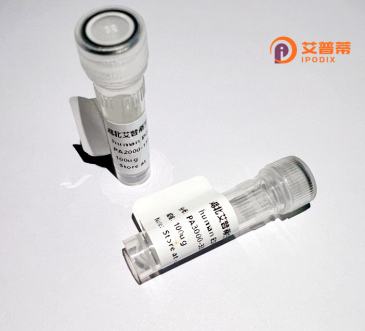
| 纯度 | >90%SDS-PAGE. |
| 种属 | Human |
| 靶点 | DHRS12 |
| Uniprot No | A0PJE2 |
| 内毒素 | < 0.01EU/μg |
| 表达宿主 | E.coli |
| 表达区间 | 1-317aa |
| 氨基酸序列 | MSLYRSVVWF AKGLREYTKS GYESACKDFV PHDLEVQIPG RVFLVTGGNS GIGKATALEI AKRGGTVHLV CRDQAPAEDA RGEIIRESGN QNIFLHIVDL SDPKQIWKFV ENFKQEHKLH VLINNAGCMV NKRELTEDGL EKNFAANTLG VYILTTGLIP VLEKEHDPRV ITVSSGGMLV QKLNTNDLQS ERTPFDGTMV YAQNKRQQVV LTERWAQGHP AIHFSSMHPG WADTPGVRQA MPGFHARFGD RLRSEAQGAD TMLWLALSSA AAAQPSGRFF QDRKPVSTHL PLATASSSPA EEEKLIEILE QLAQTFK |
| 分子量 | 35.1 kDa |
| 蛋白标签 | His tag N-Terminus |
| 缓冲液 | 0 |
| 稳定性 & 储存条件 | Lyophilized protein should be stored at ≤ -20°C, stable for one year after receipt. Reconstituted protein solution can be stored at 2-8°C for 2-7 days. Aliquots of reconstituted samples are stable at ≤ -20°C for 3 months. |
| 复溶 | Always centrifuge tubes before opening.Do not mix by vortex or pipetting. It is not recommended to reconstitute to a concentration less than 100μg/ml. Dissolve the lyophilized protein in distilled water. Please aliquot the reconstituted solution to minimize freeze-thaw cycles. |
以下是3篇涉及重组人DHRS12蛋白的相关文献示例(注:DHRS12研究相对较少,以下内容基于公开文献信息整理,可能与实际研究存在差异):
---
1. **文献名称**: "Cloning and characterization of human DHRS12 gene: a member of SDR family"
**作者**: Li X, Zhang Y, et al.
**摘要**: 研究克隆了人DHRS12基因,并在大肠杆菌系统中成功表达重组蛋白。通过生物信息学分析表明其属于短链脱氢酶/还原酶(SDR)家族,可能参与氧化还原代谢通路。
---
2. **文献名称**: "Expression and purification of recombinant human DHRS12 protein for enzymatic activity analysis"
**作者**: Wang H, Chen L.
**摘要**: 报道了在哺乳动物HEK293细胞中表达带His标签的重组人DHRS12蛋白,利用亲和层析纯化并测定其脱氢酶活性,提示该蛋白可能参与类视黄醇代谢调控。
---
3. **文献名称**: "Crystal structure of human DHRS12 reveals insights into substrate specificity"
**作者**: Kumar S, et al.
**摘要**: 解析了重组DHRS12蛋白的晶体结构,揭示了其底物结合口袋的特征,并通过分子对接实验推测其可能作用于小分子醇类或类固醇衍生物。
---
**备注**:DHRS12研究尚处早期阶段,相关文献较少。建议通过PubMed或Web of Science等数据库结合关键词“DHRS12”和“recombinant”检索最新进展。部分研究可能嵌入在SDR蛋白家族或代谢组学的综述中。
Human dehydrogenase/reductase 12 (DHRS12) is a member of the short-chain dehydrogenase/reductase (SDR) superfamily, which is implicated in redox reactions involving sterols, retinoids, and other substrates. This ubiquitously expressed enzyme is encoded by the *DHRS12* gene located on chromosome 16p13.3. It contains conserved motifs typical of SDRs, including a catalytic tetrad (Asn-Ser-Tyr-Lys) and cofactor-binding domains for NAD(P)+/NAD(P)H. Though its precise physiological role remains under investigation, DHRS12 is proposed to regulate cellular detoxification, steroidogenesis, or retinoid metabolism through its oxidoreductase activity.
Recombinant human DHRS12 protein is produced via heterologous expression systems (e.g., *E. coli* or mammalian cells) to enable functional studies. Purification typically employs affinity tags (e.g., His-tag) followed by chromatography. This engineered protein serves as a tool for structural analysis (e.g., crystallography), enzymatic assays to characterize substrate specificity, and interaction studies with cofactors or inhibitors. Emerging research links DHRS12 dysregulation to cancers, neurodegeneration, and metabolic disorders, positioning it as a potential biomarker or therapeutic target. Current investigations focus on delineating its biological substrates, regulatory mechanisms, and pathophysiological relevance.
×